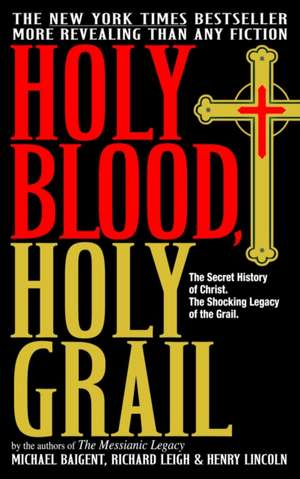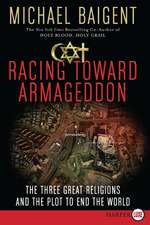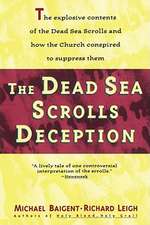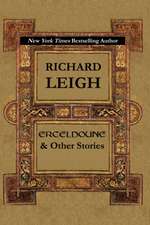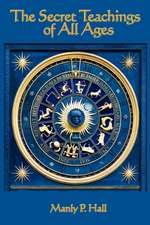Holy Blood, Holy Grail
Autor Michael Baigent, Richard Leigh, Henry Lincolnen Limba Engleză Paperback – 31 dec 2003
• Is it possible Christ did not die on the cross?
• Is it possible Jesus was married, a father, and that his bloodline still exists?
• Is it possible that parchments found in the South of France a century ago reveal one of the best-kept secrets of Christendom?
• Is it possible that these parchments contain the very heart of the mystery of the Holy Grail?
According to the authors of this extraordinarily provocative, meticulously researched book, not only are these things possible — they are probably true! so revolutionary, so original, so convincing, that the most faithful Christians will be moved; here is the book that has sparked worldwide controversey.
"Enough to seriously challenge many traditional Christian beliefs, if not alter them."
— Los Angeles Times Book Review
"Like Chariots of the Gods?...the plot has all the elements of an international thriller."
— Newsweek
From the Paperback edition.
Preț: 113.23 lei
Nou
Puncte Express: 170
Preț estimativ în valută:
21.67€ • 22.62$ • 17.93£
21.67€ • 22.62$ • 17.93£
Carte disponibilă
Livrare economică 14-28 martie
Preluare comenzi: 021 569.72.76
Specificații
ISBN-13: 9780385338455
ISBN-10: 0385338457
Pagini: 489
Dimensiuni: 171 x 209 x 27 mm
Greutate: 0.4 kg
Editura: DELTA
ISBN-10: 0385338457
Pagini: 489
Dimensiuni: 171 x 209 x 27 mm
Greutate: 0.4 kg
Editura: DELTA
Notă biografică
Michael Baigent was born in New Zealand in 1948 and obtained a degree in psychology from Canterbury University. At one point he gave up a successful career in photojournalism to devote his time to researching the Templars for a film project. Since 1976 he has lived in England.
Richard Leigh is a novelist and short-story writer with postgraduate degrees in comparative literature and a thorough knowledge of history, philosophy, psychology, and esoterica. He has been working for some years as a university lecturer in the United States, Canada, and Britain.
Henry Lincoln is an author and filmmaker and has written for television.
From the Hardcover edition.
Richard Leigh is a novelist and short-story writer with postgraduate degrees in comparative literature and a thorough knowledge of history, philosophy, psychology, and esoterica. He has been working for some years as a university lecturer in the United States, Canada, and Britain.
Henry Lincoln is an author and filmmaker and has written for television.
From the Hardcover edition.
Extras
Introduction
In 1969, en route for a summer holiday in the Cévennes, I made the casual purchase of a paperback. Le Trésor Maudit by Gérard de Sède was a mystery story--a lightweight, entertaining blend of historical fact, genuine mystery, and conjecture. It might have remained consigned to the postholiday oblivion of all such reading had I not stumbled upon a curious and glaring omission in its pages.
The "accursed treasure" of the title had apparently been found in the 1890s by a village priest through the decipherment of certain cryptic documents unearthed in his church. Although the purported texts of two of these documents were reproduced, the "secret messages" said to be encoded within them were not. The implication was that the deciphered messages had again been lost. And yet, as I found, a cursory study of the documents reproduced in the book reveals at least one concealed message. Surely the author had found it. In working on his book he must have given the documents more than fleeting attention. He was bound, therefore, to have found what I have found. Moreover, the message was exactly the kind of titillating snippet of "proof" that helps to sell a "pop" paperback. Why had M. de Sède not published it?
During the ensuing months the oddity of the story and the possibility of further discoveries drew me back to it from time to time. The appeal was that of a rather more than usually intriguing crossword puzzle--with the added curiosity of de Sède's silence. As I caught tantalizing new glimpses of layers of meaning buried within the text of the documents, I began to wish I could devote more to the mystery of Rennes-le-Château than mere moments snatched from my working life as a writer for television. And so in the late autumn of 1970, I presented the story as a possible documentary subject to the late Paul Johnstone, executive producer of the BBC's historical and archaeological series Chronicle.
Paul saw the possibilities and I was sent to France to talk to de Sède and explore the prospects for a short film. During Christmas week of 1970 I met de Sède in Paris. At that first meeting I asked the question that had nagged at me for more than a year: "Why didn't you publish the message hidden in the parchments?" His reply astounded me. "What message?"
It seemed inconceivable to me that he was unaware of this elementary message. Why was he fencing with me? Suddenly I found myself reluctant to reveal exactly what I had found. We continued a verbal fencing match for a few minutes and it became apparent that we were both aware of the message. I repeated my question, "Why didn't you publish it?" This time de Sède's answer was calculated. "Because we thought it might interest someone like you to find it for yourself."
That reply, as cryptic as the priest's mysterious documents, was the first clear hint that the mystery of Rennes-le-Château was to prove much more than a simple tale of lost treasure.
With my director, Andrew Maxwell-Hyslop, I began to prepare a Chronicle film in the spring of 1971. It was planned as a simple twenty-minute item for a magazine program. But as we worked, de Sède began to feed us further fragments of information. First came the full text of a major encoded message, which spoke of the painters Poussin and Teniers. This was fascinating. The cipher was unbelievably complex. We were told it had been broken by experts of the French Army Cipher Department, using computers. As I studied the convolutions of the code, I became convinced that this explanation was, to say the least, suspect. I checked with cipher experts of British Intelligence. They agreed with me. "The cipher does not present a valid problem for a computer." The code was unbreakable. Someone, somewhere, must have the key.
And then de Sède dropped his second bombshell. A tomb resembling that in Poussin's famous painting "Les Bergers d'Arcadie" had been found. He would send details as soon as he had them. Some days later the photographs arrived and it was clear that our short film on a small local mystery had begun to assume unexpected dimensions. Paul decided to abandon it and committed us to a full-length Chronicle film. Now there would be more time to research and more screen time to explore the story. Transmission was postponed to the spring of the following year.
The Lost Treasure of Jerusalem? was screened in February 1972 and provoked a very strong reaction. I knew that I had found a subject of consuming interest not merely to myself but to a very large viewing public. Further research would not be self-indulgence. At some time there would have to be a follow-up film. By 1974 I had a mass of new material and Paul assigned Roy Davies to produce my second Chronicle film, The Priest, the Painter and the Devil. Again the reaction of the public proved how much the story had caught the popular imagination. But by now it had grown so complex, so far-reaching in its ramifications, that I knew the detailed research was rapidly exceeding the capabilities of any one person. There were too many different leads to follow. The more I pursued one line of investigation, the more conscious I became of how much material was being neglected. It was at this juncture that chance, which had first tossed the story so casually into my lap, now made sure that the work would not become bogged down.
In 1975 at a summer school where we were both lecturing on aspects of literature, I had the great good fortune to meet Richard Leigh. Richard is a novelist and short-story writer with postgraduate degrees in comparative literature and thorough knowledge of history, philosophy, psychology, and esoterica. He had been working for some years as a university lecturer in the United States, Canada, and Britain.
Between our summer-school talks we spent many hours discussing subjects of mutual interest. I mentioned the Knights Templar, who had assumed an important role in the background to the mystery of Rennes-le-Château. To my delight I found that this shadowy order of medieval warrior-monks had already awakened Richard's profound interest, and he had done considerable research into their history. At one stroke months of work I had seen stretching ahead of me became unnecessary. Richard could answer most of my questions, and was as intrigued as I was by some of the apparent anomalies I had unearthed. More important, he, too, saw the fascination and sensed the significance of the whole research project on which I had embarked. He offered to help me with the aspect involving the Templars. And he brought in Michael Baigent, a psychology graduate who had recently abandoned a successful career in photojournalism to devote his time to researching the Templars for a film project he had in mind.
Had I set out to search for them, I could not have found two better qualified and more congenial partners with whom to form a team. After years of solitary labor the impetus brought to the project by two fresh brains was exhilarating. The first tangible result of our collaboration was the third Chronicle film on Rennes-le-Château, The Shadow of the Templars, which was produced by Roy Davies in 1979.
The work we did on that film at last brought us face to face with the underlying foundations upon which the entire mystery of Rennes-le-Château had been built. But the film could only hint at what we were beginning to discern. Beneath the surface was something more startling, more significant, and more immediately relevant than we could have believed possible when we began our work on the "intriguing little mystery" of what a French priest might have found in a mountain village.
In 1972 I closed my first film with the words, "Something extraordinary is waiting to be found . . . and in the not too distant future, it will be."
This book explains what that "something" is--and how extraordinary the discovering has been.
Henry Lincoln
January 17, 1981
From the Paperback edition.
In 1969, en route for a summer holiday in the Cévennes, I made the casual purchase of a paperback. Le Trésor Maudit by Gérard de Sède was a mystery story--a lightweight, entertaining blend of historical fact, genuine mystery, and conjecture. It might have remained consigned to the postholiday oblivion of all such reading had I not stumbled upon a curious and glaring omission in its pages.
The "accursed treasure" of the title had apparently been found in the 1890s by a village priest through the decipherment of certain cryptic documents unearthed in his church. Although the purported texts of two of these documents were reproduced, the "secret messages" said to be encoded within them were not. The implication was that the deciphered messages had again been lost. And yet, as I found, a cursory study of the documents reproduced in the book reveals at least one concealed message. Surely the author had found it. In working on his book he must have given the documents more than fleeting attention. He was bound, therefore, to have found what I have found. Moreover, the message was exactly the kind of titillating snippet of "proof" that helps to sell a "pop" paperback. Why had M. de Sède not published it?
During the ensuing months the oddity of the story and the possibility of further discoveries drew me back to it from time to time. The appeal was that of a rather more than usually intriguing crossword puzzle--with the added curiosity of de Sède's silence. As I caught tantalizing new glimpses of layers of meaning buried within the text of the documents, I began to wish I could devote more to the mystery of Rennes-le-Château than mere moments snatched from my working life as a writer for television. And so in the late autumn of 1970, I presented the story as a possible documentary subject to the late Paul Johnstone, executive producer of the BBC's historical and archaeological series Chronicle.
Paul saw the possibilities and I was sent to France to talk to de Sède and explore the prospects for a short film. During Christmas week of 1970 I met de Sède in Paris. At that first meeting I asked the question that had nagged at me for more than a year: "Why didn't you publish the message hidden in the parchments?" His reply astounded me. "What message?"
It seemed inconceivable to me that he was unaware of this elementary message. Why was he fencing with me? Suddenly I found myself reluctant to reveal exactly what I had found. We continued a verbal fencing match for a few minutes and it became apparent that we were both aware of the message. I repeated my question, "Why didn't you publish it?" This time de Sède's answer was calculated. "Because we thought it might interest someone like you to find it for yourself."
That reply, as cryptic as the priest's mysterious documents, was the first clear hint that the mystery of Rennes-le-Château was to prove much more than a simple tale of lost treasure.
With my director, Andrew Maxwell-Hyslop, I began to prepare a Chronicle film in the spring of 1971. It was planned as a simple twenty-minute item for a magazine program. But as we worked, de Sède began to feed us further fragments of information. First came the full text of a major encoded message, which spoke of the painters Poussin and Teniers. This was fascinating. The cipher was unbelievably complex. We were told it had been broken by experts of the French Army Cipher Department, using computers. As I studied the convolutions of the code, I became convinced that this explanation was, to say the least, suspect. I checked with cipher experts of British Intelligence. They agreed with me. "The cipher does not present a valid problem for a computer." The code was unbreakable. Someone, somewhere, must have the key.
And then de Sède dropped his second bombshell. A tomb resembling that in Poussin's famous painting "Les Bergers d'Arcadie" had been found. He would send details as soon as he had them. Some days later the photographs arrived and it was clear that our short film on a small local mystery had begun to assume unexpected dimensions. Paul decided to abandon it and committed us to a full-length Chronicle film. Now there would be more time to research and more screen time to explore the story. Transmission was postponed to the spring of the following year.
The Lost Treasure of Jerusalem? was screened in February 1972 and provoked a very strong reaction. I knew that I had found a subject of consuming interest not merely to myself but to a very large viewing public. Further research would not be self-indulgence. At some time there would have to be a follow-up film. By 1974 I had a mass of new material and Paul assigned Roy Davies to produce my second Chronicle film, The Priest, the Painter and the Devil. Again the reaction of the public proved how much the story had caught the popular imagination. But by now it had grown so complex, so far-reaching in its ramifications, that I knew the detailed research was rapidly exceeding the capabilities of any one person. There were too many different leads to follow. The more I pursued one line of investigation, the more conscious I became of how much material was being neglected. It was at this juncture that chance, which had first tossed the story so casually into my lap, now made sure that the work would not become bogged down.
In 1975 at a summer school where we were both lecturing on aspects of literature, I had the great good fortune to meet Richard Leigh. Richard is a novelist and short-story writer with postgraduate degrees in comparative literature and thorough knowledge of history, philosophy, psychology, and esoterica. He had been working for some years as a university lecturer in the United States, Canada, and Britain.
Between our summer-school talks we spent many hours discussing subjects of mutual interest. I mentioned the Knights Templar, who had assumed an important role in the background to the mystery of Rennes-le-Château. To my delight I found that this shadowy order of medieval warrior-monks had already awakened Richard's profound interest, and he had done considerable research into their history. At one stroke months of work I had seen stretching ahead of me became unnecessary. Richard could answer most of my questions, and was as intrigued as I was by some of the apparent anomalies I had unearthed. More important, he, too, saw the fascination and sensed the significance of the whole research project on which I had embarked. He offered to help me with the aspect involving the Templars. And he brought in Michael Baigent, a psychology graduate who had recently abandoned a successful career in photojournalism to devote his time to researching the Templars for a film project he had in mind.
Had I set out to search for them, I could not have found two better qualified and more congenial partners with whom to form a team. After years of solitary labor the impetus brought to the project by two fresh brains was exhilarating. The first tangible result of our collaboration was the third Chronicle film on Rennes-le-Château, The Shadow of the Templars, which was produced by Roy Davies in 1979.
The work we did on that film at last brought us face to face with the underlying foundations upon which the entire mystery of Rennes-le-Château had been built. But the film could only hint at what we were beginning to discern. Beneath the surface was something more startling, more significant, and more immediately relevant than we could have believed possible when we began our work on the "intriguing little mystery" of what a French priest might have found in a mountain village.
In 1972 I closed my first film with the words, "Something extraordinary is waiting to be found . . . and in the not too distant future, it will be."
This book explains what that "something" is--and how extraordinary the discovering has been.
Henry Lincoln
January 17, 1981
From the Paperback edition.
